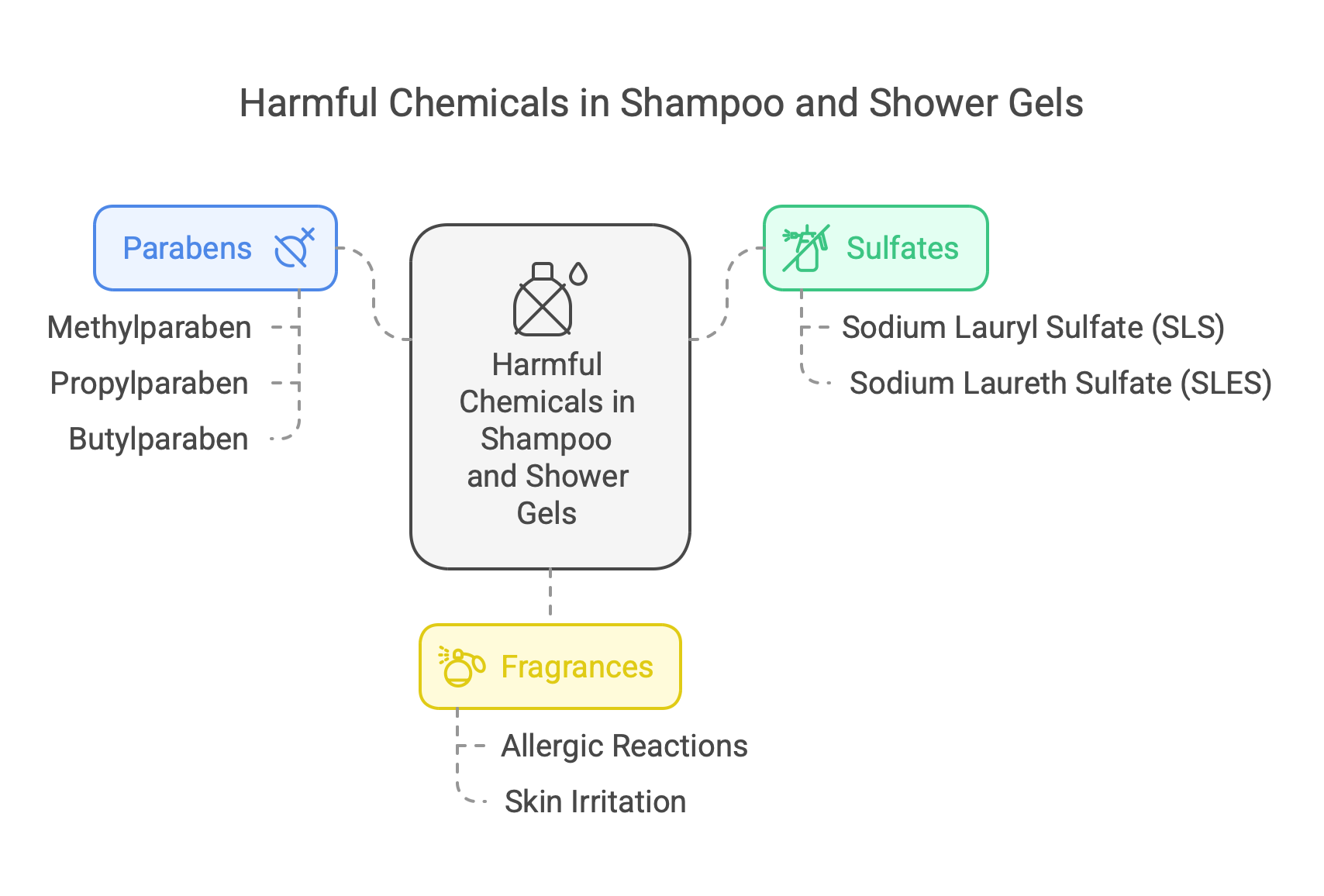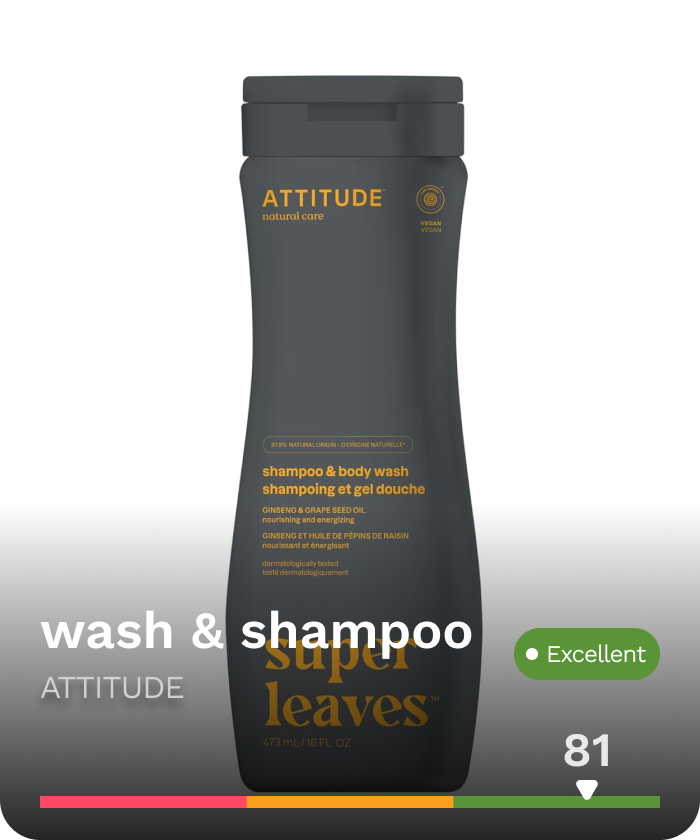TL;DR
Types of Dangerous Chemicals
Shampoos and shower gels often contain sulfates, parabens, and synthetic fragrances, which may pose health risks:
- Sulfates (SLS & SLES): Common foaming agents that strip natural oils, causing dryness and irritation. SLES may also contain 1,4-dioxane, a potential carcinogen and hormone disruptor.
- Parabens: Preservatives like methylparaben and butylparaben can disrupt hormones, potentially leading to skin irritation, reproductive issues, and cancer risks.
- Fragrances: Often undisclosed chemical mixtures that may cause allergies, irritation, and unknown long-term health effects.
Health Risks
Chemicals in shampoos and shower gels can trigger allergic reactions such as redness, itching, swelling, or severe symptoms like hives. Key allergens include:
- Fragrances and Preservatives: Common culprits like methylisothiazolinone, formaldehyde, and coconut derivatives.
- Regulated Allergens: EU regulations mandate disclosure of 80+ allergens in products exceeding specific concentrations, including Alpha-isomethyl Ionone and Linalool.
- “Hypoallergenic” Claims: Not federally regulated in the U.S.; consumers should verify ingredients through trusted regulatory sources.
Environmental Impact
Shampoos and shower gels contribute to environmental harm:
- Water Pollution: Chemicals like parabens, sulfates, and synthetic fragrances harm aquatic ecosystems, causing algal blooms, oxygen depletion, and threats to marine life.
- Microbeads: Tiny plastic particles bypass water filters, harm marine organisms, and introduce toxins into the food chain. Legislative bans in some countries aim to address this issue.
- Marine Biodiversity: Substances like oxybenzone and methylparaben disrupt marine ecosystems and biodiversity.
Eco-conscious choices, such as using natural, chemical-free products and sustainable packaging, are vital to reducing this environmental impact.
Consumer Awareness and Advocacy
For individuals with sensitive skin, selecting the right shampoo is crucial to prevent irritation and maintain scalp health.
- Irritants to Avoid: Harsh surfactants (e.g., sodium lauryl sulfate), formaldehyde releasers, parabens, and certain preservatives (e.g., methylisothiazolinone) are common triggers. Read labels carefully to identify and avoid these ingredients.
- Fragrance Concerns: Opt for genuinely fragrance-free products, as some labeled “fragrance-free” may still include skin-irritating additives.
- Soothing Alternatives: Shampoos with natural calming ingredients like aloe vera and chamomile offer gentle cleansing without stripping natural oils.
- Personalization: Consider individual hair and scalp needs, and consult a dermatologist if necessary for patch testing.
Choosing gentle, chemical-free formulations supports healthy, irritation-free hair care routines.
Alternatives to Harmful Chemicals
Consumers can minimize their environmental footprint by:
- Avoiding Harmful Ingredients: Choose products free of parabens, phthalates, and triclosan to protect marine life and reduce soil and groundwater contamination.
- Opting for Sustainable Packaging: Look for compostable packaging that breaks down into natural elements or products using post-consumer recycled (PCR) materials to reduce waste.
- Supporting Eco-Friendly Brands: Favor brands committed to sustainability, environmental impact scoring, and zero-waste, plastic-free, or low-waste initiatives.
Making informed product choices and supporting responsible companies helps reduce the beauty industry’s environmental impact.
Types of Dangerous Chemicals
Shampoo and shower gels often contain a variety of chemicals that, while effective
in cleaning, can pose significant health risks over time. One of the most common
types of chemicals found in these products are sulfates, specifically Sodium Lauryl
Sulfate (SLS) and Sodium Laureth Sulfate (SLES). SLS and SLES are used as
foaming agents to create lather, which gives the impression of thorough cleaning[1].
However, these chemicals can strip the skin and hair of their natural oils, leading to
dryness, irritation, and inflammation[11][32]. Moreover, SLES can be contaminated
with 1,4-dioxane, a potential human carcinogen that disrupts hormones and is linked
to breast cancer[1][9].
Another prevalent group of chemicals in personal care products are parabens. These
are synthetic preservatives used to prolong the shelf life of products by preventing
the growth of bacteria, mold, and yeast[29][31]. While effective in their preservative
role, parabens are endocrine disruptors that can mimic hormones in the body,
potentially leading to reproductive toxicity, immunotoxicity, neurotoxicity, and skin
irritation[3][28][30]. The most common parabens found in shampoos and shower gels
include methylparaben, propylparaben, and butylparaben[3][29].
Fragrances are another category of ingredients that often contain undisclosed chem-
icals. Many fragrances are made from synthetic compounds that can cause allergic
reactions, skin irritation, and potentially more severe health effects due to their
unknown compositions[12]. Products labeled with “fragrance” can include a variety
of undisclosed chemicals, some of which may be harmful over long-term use.
ALVA Favourites
When you make a purchase through retailer links on our site, we may earn commission through affiliate programs. All affiliate fees ALVA receives support our mission. Learn more here
Are your products safe?
Scan your products now with the ALVA app to get a personalised risk analysis.

Parabens
Parabens are synthetic preservatives commonly used in a wide range of cosmetic
and personal care products to prevent the growth of bacteria, mold, and yeast,
which can spoil these products and degrade their quality[27][29][31]. These chemi-
cals include methylparaben, ethylparaben, propylparaben, and butylparaben, among
others[31]. Parabens have been widely utilized since the 1920s and can be found
in everyday items such as shampoos, conditioners, lotions, makeup, and shaving
products[29].
The primary function of parabens in these products is to extend their shelf life and
ensure safety by preventing microbial growth[27][30]. Despite their effectiveness
in preservation, there has been growing concern about the potential health risks
associated with parabens. They are known endocrine disruptors, which means they
can interfere with hormone function in the body[28][30]. This disruption can lead
to skin irritation and potentially more serious long-term health effects, including an
increased risk of cancer[30].
Recent research has suggested that the absorption of parabens through the skin
may contribute to these adverse health effects[28]. The controversy surrounding
parabens has led to increased scrutiny, especially within the ‘clean beauty’ industry,
which advocates for safer and non-toxic ingredients in personal care products[30].
As awareness of the potential risks associated with parabens continues to grow,
consumers are increasingly seeking out paraben-free alternatives to mitigate these
health concerns[27].
Sulfates
Sulfates are a group of synthetic chemicals commonly found in personal care pro-
ducts, including shampoos and shower gels. Two of the most prevalent sulfates are
sodium lauryl sulfate (SLS) and sodium laureth sulfate (SLES). These compounds
are typically used to create a lather, which enhances the perception of the product’s
cleaning power[11][33].
Despite their widespread use, SLS and SLES have been associated with several
health concerns. Both of these chemicals are known for their ability to strip the
skin and hair of natural oils, which can lead to dryness and irritation[32]. SLS, in
particular, is recognized for causing skin irritation and dryness, and can even con-
tribute to inflammation[11]. Additionally, SLES has the potential to be contaminated
with 1,4-dioxane, a substance that has been linked to hormone disruption and an
increased risk of breast cancer[9].
The controversy surrounding sulfates extends beyond their immediate impact on skin
and hair. These compounds are often derived from petroleum, raising environmental
concerns due to the association with climate change, pollution, and greenhouse
gases[33]. Given these risks, many consumers and health experts advocate for
the use of sulfate-free products to minimize exposure to these potentially harmful
chemicals[7].
Health Risks
Common chemicals in shampoos and shower gels can cause a variety of skin
irritations and allergic reactions, including redness, itching, swelling, and in severe
cases, anaphylaxis or hives[22][26]. These reactions are often the result of allergic
contact dermatitis, which occurs when the immune system overreacts to certain
ingredients[24]. Among the most common allergens found in these products are
fragrance chemicals, preservatives such as methylisothiazolinone and formaldehyde,
and coconut derivatives[22][26].
Regulations require that certain allergens must be listed on product labels if they
exceed specific concentrations. For example, under EU Regulation 2023/1545, more
than 80 cosmetic fragrances classified as allergens must be disclosed[21]. Similarly,
Regulation 1223/2009 mandates the inclusion of 26 specific allergens on the ingre-
dient list of cosmetics if they exceed 0.01% in rinse-off products like shampoos and
shower gels[23].
Consumers can identify these allergens by reading the International Nomenclature
of Cosmetic Ingredients (INCI) list on product labels[23]. This list includes common
allergens such as Alpha-isomethyl Ionone, Benzyl Alcohol, Cinnamal, and Linalool,
among others[23]. Additionally, products labeled as “hypoallergenic” or “for sensitive
skin” are not regulated under a federal standard in the United States, so it is essential
for consumers to consult lists of known allergens provided by regulatory bodies like
the FDA and the EU[21].
Individuals experiencing allergic reactions to these products should immediately
rinse the affected area with water and discontinue use. Mild symptoms may be
treated with hydrocortisone cream or antihistamines, but severe reactions warrant
consultation with a healthcare provider or allergist[22]. Identifying allergens through
patch testing can also be a useful diagnostic tool for those with recurrent skin
issues[25].
Environmental Impact
Shampoos and shower gels are essential personal care products, but they pose
significant environmental challenges due to their chemical compositions. Traditional
shampoos often contain harmful substances such as parabens, sulfates, and syn-
thetic fragrances, which can have detrimental effects on aquatic ecosystems when
they enter waterways[14][16]. These chemicals contribute to water pollution, leading
to issues such as algal blooms, dead zones, and increased bacterial growth, which
in turn reduce oxygen levels in the water, affecting marine life[13].
Microbeads, which are tiny plastic particles used in some shower gels and facial
scrubs, also contribute to water pollution. These microbeads bypass water filters and
end up in the ocean, where they are ingested by fish and other marine organisms,
causing physical harm and introducing toxic substances into the food chain[19][20].
The presence of microbeads has led to legislative actions in various countries,
including the United States and the United Kingdom, which have implemented bans
on their use in personal care products[19].
Moreover, the harmful effects of chemicals such as oxybenzone, octinoxate, methyl-
paraben, and propylparaben in personal care products extend beyond water quality
degradation. These substances can significantly impact marine biodiversity, disrupt-
ing the health of marine ecosystems[18]. As consumers become more environmen-
tally conscious, the demand for all-natural and eco-friendly alternatives to traditional
shampoos and shower gels is increasing[14][16]. Choosing products free from harm-
ful chemicals and opting for sustainable packaging can mitigate the environmental
impact and help protect aquatic life and ecosystems[17].
Consumer Awareness and Advocacy
For individuals with sensitive skin, choosing the right shampoo is imperative to avoid
irritation and other adverse reactions. Sensitive skin can react to a variety of triggers,
including ingredients commonly found in shampoos. Dermatologists emphasize the
importance of selecting products that cater specifically to sensitive skin to prevent
issues such as redness, itching, and flakiness[40][42][45].
Consumers should be aware of the common chemical irritants to avoid when select-
ing hair care products. Ingredients such as harsh surfactants, sulfates (like cocamido-
propyl betaine and sodium lauryl sulfate), formaldehyde releasers (such as DMDM
hydantoin and quaternium 15), parabens (like methylparaben and propylparaben),
and certain preservatives (including methylchloroisothiazolinone and methylisothia-
zolinone) are known to cause irritation in sensitive individuals. Reading product labels
and understanding what your skin can and cannot tolerate is crucial[41].
Moreover, products labeled as “fragrance-free” may still contain fragrance-like ingre-
dients that can trigger reactions in sensitive skin. Therefore, opting for shampoos
that are truly free from such additives is essential. It’s recommended to consult
with a dermatologist or allergist for patch testing if there is uncertainty about what
ingredients may cause skin reactions[41].
The benefits of using shampoos formulated for sensitive skin include gentle cleansing
without stripping natural oils, reduced irritation, and the inclusion of soothing natural
extracts like aloe vera and chamomile. These ingredients help maintain a healthy
scalp and hair, minimizing discomfort and potential damage[42][43].
Ultimately, selecting the appropriate shampoo involves considering individual hair
types and scalp sensitivities, avoiding harsh chemicals, and focusing on gentle,
soothing formulations. By making informed choices, consumers can mitigate the
health risks posed by dangerous chemicals in shampoos and ensure their hair care
routines support overall skin health[43][44].
Alternatives to Harmful Chemicals
Consumers seeking to minimize the environmental impact of their personal care
product choices can take several measures. One of the first steps is to avoid
ingredients that are harmful to the environment, such as parabens, phthalates, and
triclosan, which can be toxic to marine life and may seep into groundwater and soil,
causing damage to plants and animals[38]. Instead, opting for earth-friendly products
that are free from harsh chemicals and come with minimal packaging can make a
significant difference[38].
In addition to choosing products with safer ingredients, consumers can look for
sustainable and innovative product packaging options. Compostable packaging is
gaining popularity as it breaks down into natural elements when composted, reducing
waste and environmental impact. Compostable materials, once repurposed, turn into
nutrient-dense soil that can be used in gardens and farms rather than decomposing in
landfills and releasing emissions[35]. Another sustainable packaging trend involves
using post-consumer recycled (PCR) materials, which help reduce plastic waste by
repurposing already existing plastic products[35].
Furthermore, consumers can support brands that focus on sustainability and environ-
mental responsibility. Many companies are developing environmental impact scoring
systems for their products, allowing consumers to quickly assess the sustainability of
different brands and make informed choices. Major companies like Henkel, L’Oréal,
Unilever, LVMH, and Natura & Co are spearheading this initiative[37]. Supporting
brands that prioritize zero-waste, plastic-free, or low-waste packaging is also benefi-
cial. These brands often use biodegradable, compostable, or reusable packaging to
minimize environmental impact[39].
Ultimately, by making conscious choices about the personal care products they use
and supporting sustainable brands, consumers can play a vital role in reducing the
environmental footprint of the beauty industry[36].
References
[1]: What’s in your Body Wash? Top 6 ingredients to avoid.
[2]: The Chemicals to Avoid in Your Shampoo and Body Wash – Healthline
[3]: Toxic chemicals in cosmetics and beauty products
[4]: What are the components to avoid in a shower gel formula? – Typology Paris
[5]: Chemicals To Avoid In Skincare Products | Ingredients List Checker.
[6]: The Chemicals to Avoid in Your Shampoo and Body Wash – Healthline
[7]: 17 Dangerous Ingredients to Avoid in Hair Care Products – Consumer Notice
[8]: 12 Chemicals in Personal Care Products You Should Avoid: The Dirty …
[9]: What’s in your Body Wash? Top 6 ingredients to avoid.
[10]: Potentially harmful chemicals hiding in everyday products
[11]: Looking for a New Shampoo? You May Want to Avoid These … – Healthline
[12]: Safer shampoo: Steer clear of these problematic ingredients
[13]: Impact of Cleaning Products on Water Quality – Tru Earth US
[14]: The Environmental Impact of All-Natural Shampoos: A Sustainable … – Viori
[15]: The Impact of Sustainable Cleaning Products on Health and Environment
[16]: How Your Shampoo Affects the Environment, Plus Sustainable Recs
[17]: How Your Beauty Routine May Be Polluting Our Water Supply
[18]: The Harmful Effects of Chemicals in Everyday Products on Marine Life
[19]: Why microbeads in shower gels are bad for marine life
[20]: These Cleaning Products Are Harmful To Fish Sea Life – Refinery29
[21]: Allergens in Cosmetics – What You Need to Know
[22]: Shampoo Allergic Reactions: Symptoms & Common Allergens – Verywell Health
[23]: From 26 to 82 – longer list of allergens? – Safety Assessment
[24]: Chemical Allergies: Shampoo, Cleaners, and More – WebMD
[25]: Allergens in Popular Hair Products May Cause Allergic Contact …
[26]: Shampoo Allergy: Symptoms, Causes, Diagnosis, and Prevention – Wyndly
[27]: Dermatologists Warn About the No. 1 Ingredient to Avoid in Your …
[28]: How Do Parabens Harm The Skin And Why Should You Avoid Them In Soap?
[29]: Parabens: What You Should Know About These Commonly Used Chemicals –
[30]: Parabens: The Truth About Parabens – Are They Actually Harmful?
[31]: Are Parabens Harmful to Skin? – iCliniq
[32]: Sodium Lauryl Sulfate: Is It Really As Bad As Everyone Says?
[33]: Are Sulfates Good or Bad for You? Know the Facts – Healthline
[34]: Sustainability: How to measure the impact of cosmetic products?
[35]: Top 10 Sustainability Trends in Personal Care Products
[36]: Sustainable Personal Care And Beauty – Sigma Earth
[37]: Sustainability in the Personal Care and Cosmetics Industry
[38]: Sustainable Beauty: How To Choose Earth-Friendly Personal Care Products …
[39]: Eco-Friendly Beauty and Personal Care Products – ORGANIC BEAUTY LOVER
[40]: 11 Best Shampoo for Sensitive Skin That Won’t Irritate – Well+Good
[41]: 5 Tips When Buying the Best Sensitive Skin Shampoo | Vanicream
[42]: Best Shampoos For Sensitive Skin (2024 Update) – Pubbelly
[43]: Why Should You Choose Shampoo for Sensitive Skin?
[44]: 14 Best Shampoos For Sensitive Skin As Per Dermatologist, 2024
[45]: 18 Hair Products Dermatologists Recommend for Sensitive Skin
[45]: 18 Hair Products Dermatologists Recommend for Sensitive Skin
Are your products save?
Download ALVA to check if the products you use regularly are free from dangerous chemicals.

